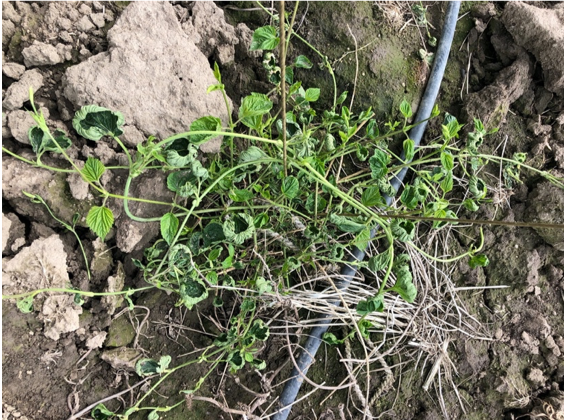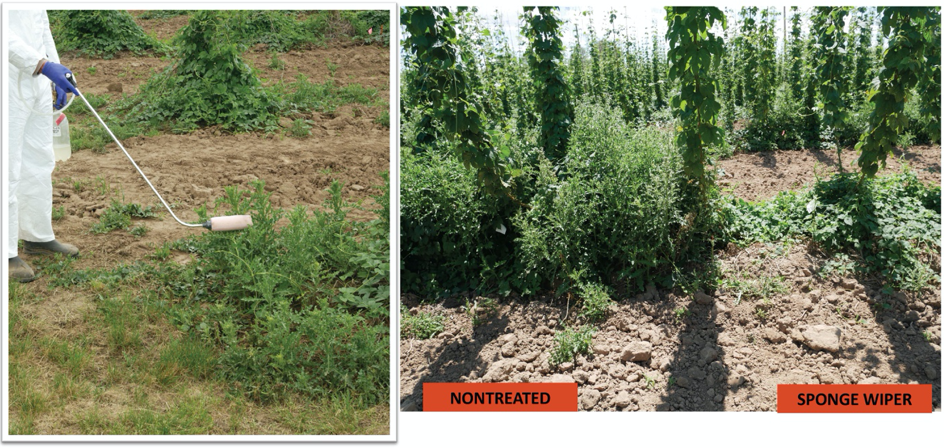Stinger herbicide is labeled for hops grown in Idaho, Oregon, or Washington. Stinger can be broadcast applied or used as a spot-treatment by hand-held sprayer. Stinger’s active ingredient, clopyralid, is a synthetic auxin herbicide with both foliar and soil activity. Clopyralid is effective on several weed species, including Canada thistle, for which it is often used in hops. Canada thistle is a perennial weed species that commonly distributes patchily across a field. Spot-treatments limit herbicide applications to the sites where weeds are a problem, minimizing herbicide use and costs. Those are compelling reasons to use spot-treatment, right?
Here comes the plot twist:
Spot spraying with a backpack is not accurate.
Many things contribute to spot spraying’s intrinsic variability, including travel speed, spray pressure, and nozzle height. Travel speed is the most challenging aspect to hold consistent. Over a day, the applicator tends to lose stamina and move more slowly. Some applicators slow down for larger weeds and over-apply. A manual pump controls spray pressure. The constant need to stroke the pump will likely be affected by applicator stamina. Low-pressure applications come with reduced rates and efficacy. Conversely, excessive pressure leads to high rates and drift-prone fine droplets. Pressure regulators can minimize this problem, but only if consistently used. The height of the nozzle affects the area treated. The closer to the ground the nozzle is placed, the smaller the treated area, resulting in higher application rates if everything else is held constant. In the case of clopyralid in hops, high rates can lead to crop damage even when the hop foliage is not directly sprayed (Figure 1). Plant roots can take up clopyralid, and some species, like hops, are more sensitive than others, like Canada thistle. Try remembering these factors while carrying over 40 lbs on your back, walking on uneven terrain, in inclement weather.
 Figure 1. Clopyralid injury in hops after spot-treatment. Excessive rates can injury the crop through soil and foliage uptake.
Figure 1. Clopyralid injury in hops after spot-treatment. Excessive rates can injury the crop through soil and foliage uptake.
What alternatives to clopyralid spot-spraying do hop growers have? The Hop Research Council and Idaho, Oregon, and Washington Hop Commissions have funded a project to evaluate Stinger’s application by sponge wiper (Figure 2 left). We used a sponge spray wand attachment made by Smucker. This unit fits in a backpack or on any pump sprayer, making more uniform application easier by keeping the sponge wet. Clopyralid applied with a sponge wiper can help reduce the amount of pesticide applied compared to spot broadcast or spot spraying. A 2% concentration of Stinger was enough to control Canada thistle (Figure 2 right). However, two applications 30 days apart provided greater control. No crop injury was observed with sponge application in our studies. We are now working with the manufacturer to include this new use pattern on the label for hops.
 Figure 2. Example of clopyralid applied with a sponge wiper (left). Mid-season picture of Canada thistle in a hopyard. The nontreated research plot is next to a sponge-wiper treated plot, showing the efficacy of the application method.
Figure 2. Example of clopyralid applied with a sponge wiper (left). Mid-season picture of Canada thistle in a hopyard. The nontreated research plot is next to a sponge-wiper treated plot, showing the efficacy of the application method.